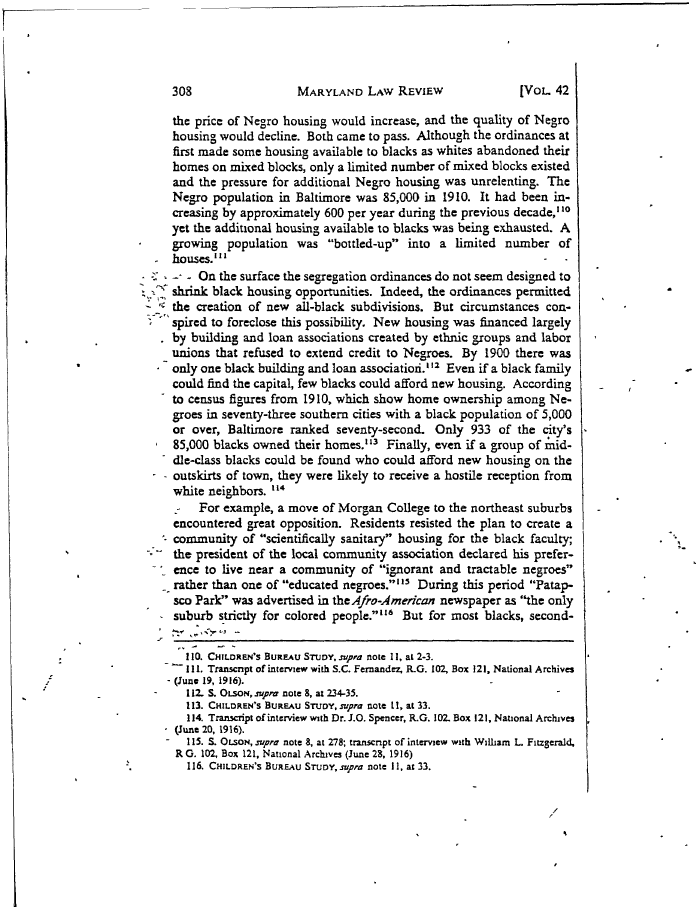 |
||||
|
Garrett Power, Apartheid Baltimore Style: The Residential Segregation Ordinances of 1910-1913, Maryland Law Review, 42 (1983) , Image No: 21 Enlarge and print image (62K) << PREVIOUS NEXT >> |
 |
||||
|
Garrett Power, Apartheid Baltimore Style: The Residential Segregation Ordinances of 1910-1913, Maryland Law Review, 42 (1983) , Image No: 21 Enlarge and print image (62K) << PREVIOUS NEXT >> |
| 308 MARYLAND LAW REVIEW [VOL. 42 the price of Negro housing would increase, and the quality of Negro housing would decline. Both came to pass. Although the ordinances at first made some housing available to blacks as whites abandoned their homes on mixed blocks, only a limited number of mixed blocks existed and the pressure for additional Negro housing was unrelenting. The Negro population in Baltimore was 85,000 in 1910. It had been in- creasing by approximately 600 per year during the previous decade,110 yet the additional housing available to blacks was being exhausted. A growing population was "bottled-up" into a limited number of houses.111 On the surface the segregation ordinances do not seem designed to shrink black housing opportunities. Indeed, the ordinances permitted the creation of new all-black subdivisions. But circumstances con- spired to foreclose this possibility. New housing was financed largely by building and loan associations created by ethnic groups and labor unions that refused to extend credit to Negroes. By 1900 there was only one black building and loan association.112 Even if a black family could find the capital, few blacks could afford new housing. According to census figures from 1910, which show home ownership among Ne- groes in seventy-three southern cities with a black population of 5,000 or over, Baltimore ranked seventy-second. Only 933 of the city's 85,000 blacks owned their homes.113 Finally, even if a group of mid- dle-class blacks could be found who could afford new housing on the - outskirts of town, they were likely to receive a hostile reception from white neighbors. 114 For example, a move of Morgan College to the northeast suburbs encountered great opposition. Residents resisted the plan to create a community of "scientifically sanitary" housing for the black faculty; the president of the local community association declared his prefer- ence to live near a community of "ignorant and tractable negroes" rather than one of "educated negroes."113 During this period "Patap- sco Park" was advertised in the Afro-American newspaper as "the only suburb strictly for colored people.116 But for most blacks, second- 110. CHILDREN'S BUREAU STUDY, supra note II, ai 2-3. ' 111. Transcript of interview with S.C. Fernandez, R.G. 102, Box 121, National Archives - (June 19, 1916). 112. S. OLSON, supra note 8, at 234-35. 113. CHILDREN'S BUREAU STUDY, supra note 11, at 33. 114. Transcript of interview with Dr. J.O. Spencer, R.G. 102, Box 121, National Archives - (June 20, 1916). 115. S. OLSON, supra note 8, at 278; transcript of interview with William L. Fitzgerald, RG. 102, Box 121, National Archives (June 28, 1916) 116. CHILDREN'S BUREAU STUDY, supra note 11, at 33. |